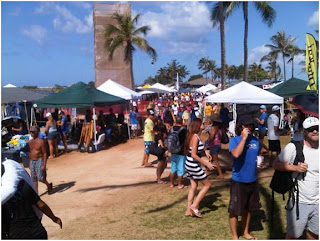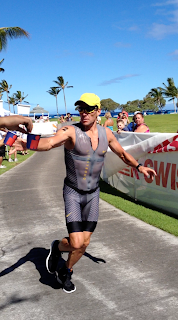The long-awaited day has come, States are on and the top paddlers in their category have gathered at Ke`ehi Lagoon, just south of Honolulu International Airport. Approximately 3,500 athletes, representing 58 canoe clubs from 6 islands have shipped their club’s prized koa canoe to O`ahu, have booked flights and often hotel rooms, to be at the biggest event of regatta paddling, the Hawaiian Canoe Racing Association’s 2012 Championships, where gold, silver and bronze medals are awarded to individual crews in 41 races, ranging in distance from one-half mile to one and one-half miles. Additionally, clubs win top honors based on total points earned in each race, and since they range in size from very small (sometimes with only enough paddlers to compete in 4 or 5 races) to very large (having a qualified crew in each one of the 41 races), they are categorized into 4 categories (AAAA for very large to A for small), with each category crowning a winner.
I chose to join my club on Saturday morning, taking an early flight from Kona to Honolulu. As we all know, traveling nowadays is quite cumbersome, with security and all, so going to a sporting event with sports drinks and gels and a paddle requires some careful packing and labeling (just imagine picking your paddle out of 3,500 paddles showing up on the luggage carousel).
The next task is getting to Ke`ehi Lagoon, exactly 1.7 miles from the Interisland Terminal. It obviously doesn’t pay to rent a car for the day, as you would only drive 3.4 miles total and would have to worry about tight parking at the beach park, and taxis really don’t like to give up their place in the line-up and miss an almost certain Waikiki fare for a whole lot less money going just down the road. So the easiest is to either look out for other paddlers who have arranged a pick-up from someone and ask to join them (most often on the back of a pick-up truck), or to take a little walk along the international terminal, through an industrial area down to the beach park.
Upon arrival at Ke`ehi Lagoon, you are greeted by dozens and dozens of tents, which are either part of the retail and food village, or belong to each one of the clubs.
Since most paddlers and their families spend the entire day there, food booths are plentiful and at some point, everyone goes to get something to eat and drink. Beyond that, there are many exciting booths selling everything from clothing to paddling equipment, from Hawaiian jewelry to arts and crafts. It is quite a display and one can wander for a long time browsing and taking it all in.
The club tents are lined up along the shoreline, with the larger clubs having tents right on the water and smaller ones relegated to the back row – which means they have to find a spot at the water’s edge to get in and out of their canoe, and to move their canoe carefully onto the beach while waiting for their next race.
Besides the retail village and actual racing, a big part of attending state championships is mingling with clubs from other islands and talking to paddlers that you may not have seen for quite a while. After I got settled in Kai`Opua’s tent and assisted with a few remaining tasks, I started to visit my friends from Maui (Kihei Canoe Club, Wailea Canoe Club, Hawaiian Canoe Club) as well as those from Kaua`i, many of whom I have raced with over the years, and also a few individuals who had been part of our historic voyage through the Northwestern Hawaiian Islands (in particular my dear friend Kimokeo). It is equally fun to see some of the true legends of the sport, individuals who have given up their private life for paddling and for their clubs and who love to share their passion with anyone. One such individual is Uncle Nappy Napoleon, founder of Anuenue Canoe Club, an individual who has paddled all of his life and at age 72 is still as fit and comfortable on the water as paddlers half his age. He is an amazing person, (and my friend Kimokeo reminds me of him as a slightly younger, yet equally driven individual) and it is just an honor to be around him.
Besides attendees like Uncle Nappy or Kimokeo, there are also today’s superstar-paddlers one can admire. Some of them are Hawai`i born and raised who not only made it big in outrigger canoe paddling, but found also success in other sports - Lauren Bartlett-Spalding is such an individual, who represented the United States in the Athens Olympics in kayaking, or the Dolan brothers, two young men who spend a lot of time in the U.S. Olympic training center.
http://www.kaiwaa.com/media/videos (check out the Jibofo POV Maliko video – great shots of the Northshore of Maui)
But back to the canoe racing. As mentioned earlier, there are 41 races taking place, from 12- year old boys and girls to 65-year old men and women, with many races being mixed (three men and three women). Racing started after a traditional Hawaiian blessing at 8:30am, and the last race of the day took place just before 6pm. Each race has 14 canoes lined up, stretching all the way from the airport side of Ke`ehi Lagoon south across the lagoon towards Waikiki.
The day progressed nicely (and as you can see, it was a spectacularly blue sky, but also very hot) and Kai `Opua Canoe Club, as one of the biggest canoe clubs in the state, went head to head with Lanikai and Kailua (both located on windward `Oahu), as well as Hawaiian Canoe Club (from Maui) leading the day in the overall classification, with one club winning a race and pulling ahead in points until another one did the same. As a matter of fact, all clubs stayed together until 5 races before the end, when Lanikai pulled ahead and eventually won top honors with 330 overall points, followed by Kailua with 329 and Hawaiian with 325. Kai `Opua finished fourth with 301, safely ahead of the rest of the clubs in the division. From a club perspective, we finished at expectation and were quite happy, and given the close point totals, we could have easily been higher (as you can see, the first three clubs were separated by only 5 points, which is quite remarkable and highly unusual).
In our men’s division, we made some last-minute changes to our crew line-ups and instead of racing with the Men’s 50’s (my crew for most of the season), I ended up paddling with a Mixed 40’s crew (three women, three men), a race I did a couple of times during the season. Since regattas are all about kokua and doing what is right for the club, I set my personal preference aside and let Coach Eddie put me into the race he needed me most. We started out fairly good but ran into some trouble around the turn, and in the end did not get a medal but received a handful of points towards the club total.
I obviously watched the 50’s race with great interest as my heart really was with that crew, and some of the best paddlers in the state lined up for that race. Given our record on Hawai`i Island during the season, we thought we could get a medal, but it is always hard to predict as things can happen on the course and sometimes a split-second can make the difference between first and fifth. The race went off and Kai `Opua, in lane three, had a good start, pushing ahead down the lane towards the turn flag. Everyone was somewhat bunched together at the turn, and when the canoes came out of the turn, the canoes on the outside (lanes ten and above) came out first. Not much changed down the stretch and when the finish flag went up, Lanikai, Outrigger, Manu O Ke Kai and Puna (our fierce competitors throughout the season) all finished together, in that order, in the outside lanes, separated by only 61/100 of a second. Kai `Opua finished next, 1.79 seconds behind in fifth place, closing out the regatta season in a respectable, but not victorious manner.
My first Moku O Hawai`i regatta season has come to an end, with many new friends gained and experiences made, not to mention the weekly drives to Hilo over Saddle Road. It was a great way to spend the summer and it really connected me even deeper with this beautiful island and its people, something that is inherent to the canoe culture.
What’s next? Long-distance canoe season looms, but I have to evaluate my participation this year as training (and racing) are far more strenuous and I am faced with lots of work and travel related to my day-job. I will keep you informed as time goes on and let you know where I stand.
Until then, a hui hou, mālama pono, me ke aloha a me ka ha`aha`a.
Aloha!























